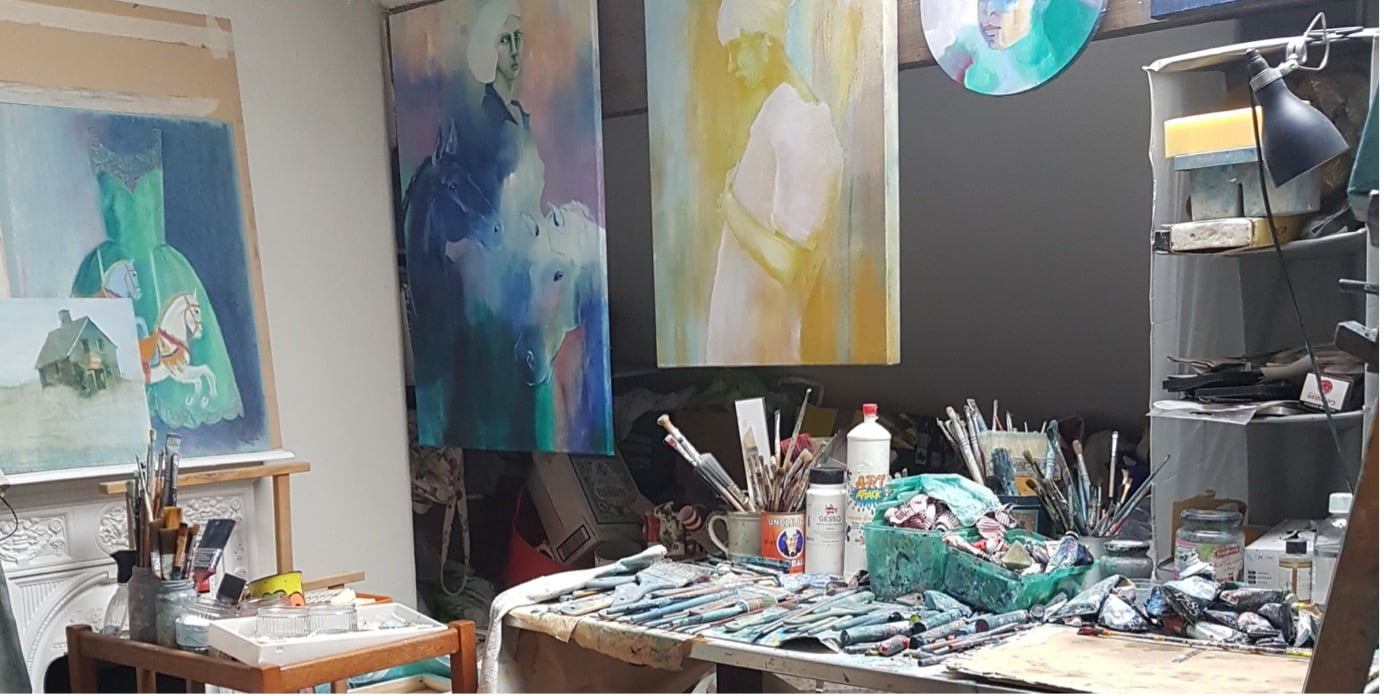
View of the attic studio.
Caroline Brown is an artist who daydreams in paint. Dreams and reveries, imaginary portraits inspired by birds and beasts, flowers and trees, vintage fashion, toys and textiles all find their way into her ethereal figurative paintings that have a wonderfully whimsical feel. Working from her attic in Bingley, the space serves as her art studio, office space for the vintage business that she runs with her husband, and storage space for vintage clothing and an assortment of household items.
As she carves time out for painting and reflection, she becomes absorbed in mysterious worlds emerging from the canvas and is transported into another space entirely. Court had a catch up with her to find out more about her process, practice and what inspires her to paint.
Court: Caroline thank you so much for your time. And thank you for your submission to The Mercer Open. I absolutely love the piece that’s going into the show. So how long have you been painting for?
Caroline: I had periods of painting full-time whilst organising group exhibitions in empty shop spaces and other venues in Brighton, London and the South East for three years. I then had a break between 2007 and 2015 and that felt like an eternity. Other than that, I’ve been painting fairly continually since I was a teenager, whenever full-time work and studying allowed. So you could say a good three decades, on and off really.
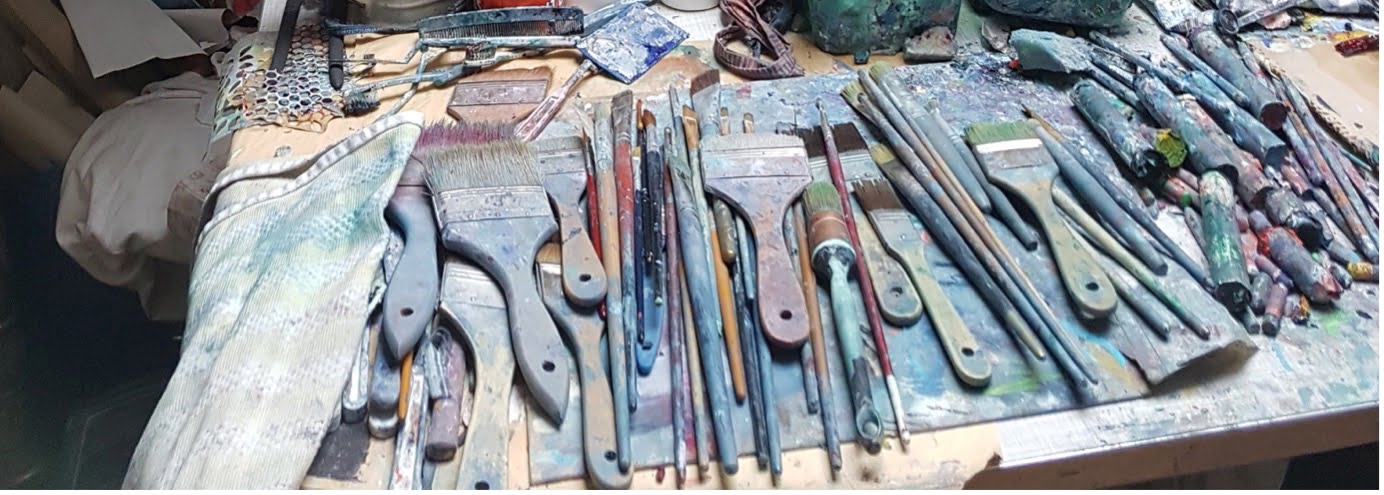
Painting materials in the studio.
Court: That’s brilliant that you’ve been able to dedicate time to panting so consistently! Were you always interested in painting?
Caroline: As a child I was always doing something creative, making illustrated books, pretending I was a fashion designer, making cards. When I inherited my grandmother’s oil paints, brushes and palette at about the age of 12, that’s where the seed of a long romance with painting in oils began. She’d only started painting very late in life, and she didn’t have enough time to get into it before she died. When the oil paints passed to me, I felt honoured to pick up the baton, and it wasn’t long before I discovered that I loved everything about them, the smell and the rich colours. It felt like there was so much to learn, and it still does – so yes, it’s always been painting for me.
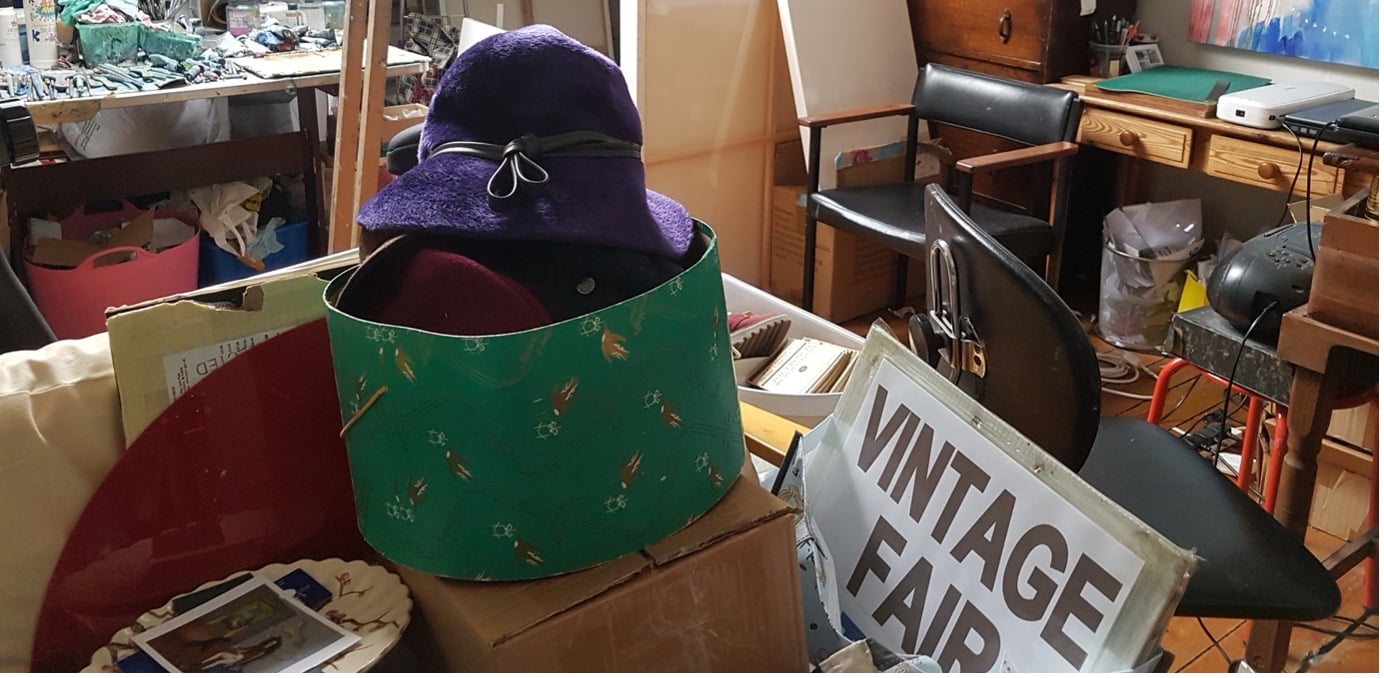
The attic space that functions as studio along with office and storeroom for Rose & Brown Vintage.
Court: That feels like quite a pivotal moment to inherit those oil paints. It almost combines the vintage and art aspects. Can you talk a little about how your interest in vintage came about, how you grew the business – Rose & Brown, and how this has influenced your artistic practice?
Caroline: I guess I’m an old-fashioned soul. Growing up, I helped my mum (Rose) who was a housekeeper at the ‘Big House’ in the village. I’d clean the bedrooms as a Saturday job and help with the clearing up after dinner parties. All that old china, silver cutlery, antique books, vintage kitchenalia that was still in use, and the wobbling sound of the parquet floor, really stuck with me, and I became interested in the stories and charm of second-hand, vintage and antique things. When I moved to Huddersfield for University, the second-hand Open Market was great for finding vintage clothing and I built up a collection of 1960s velvet mini dresses.
I met my husband Julian in Huddersfield. Little was he to know that some 13 years later he would become a partner in my business, Rose & Brown Vintage, eventually running two vintage shops together in Saltaire, West Yorkshire, as well as organising numerous Vintage Fairs in the North of England. The vintage business was all consuming for the first 8 years, but I tried to stay creative by organising fashion shows and doing regular photo shoots to promote the vintage fairs. Some of these photos were the initial inspiration for my painting practice when I finally returned to painting in 2015. I think the look and feel of vintage fashion, textiles, toys, photographs and things like doll’s houses and old dressing up boxes still influence my paintings.
Court: What did you study at uni?
Caroline: I graduated in Commercial Interior Design, and although I loved studying and devoted myself to the degree, I didn’t come away thinking it was my chosen career. I’d been very lucky that the tutor allowed me to express some of my design concepts with semi-abstract paintings or bizarre pastel sketches. But I knew that wouldn’t happen in the real world. I was happier working part-time in administrative jobs developing my organising skills and still having enough time to paint, and to start to exhibit.
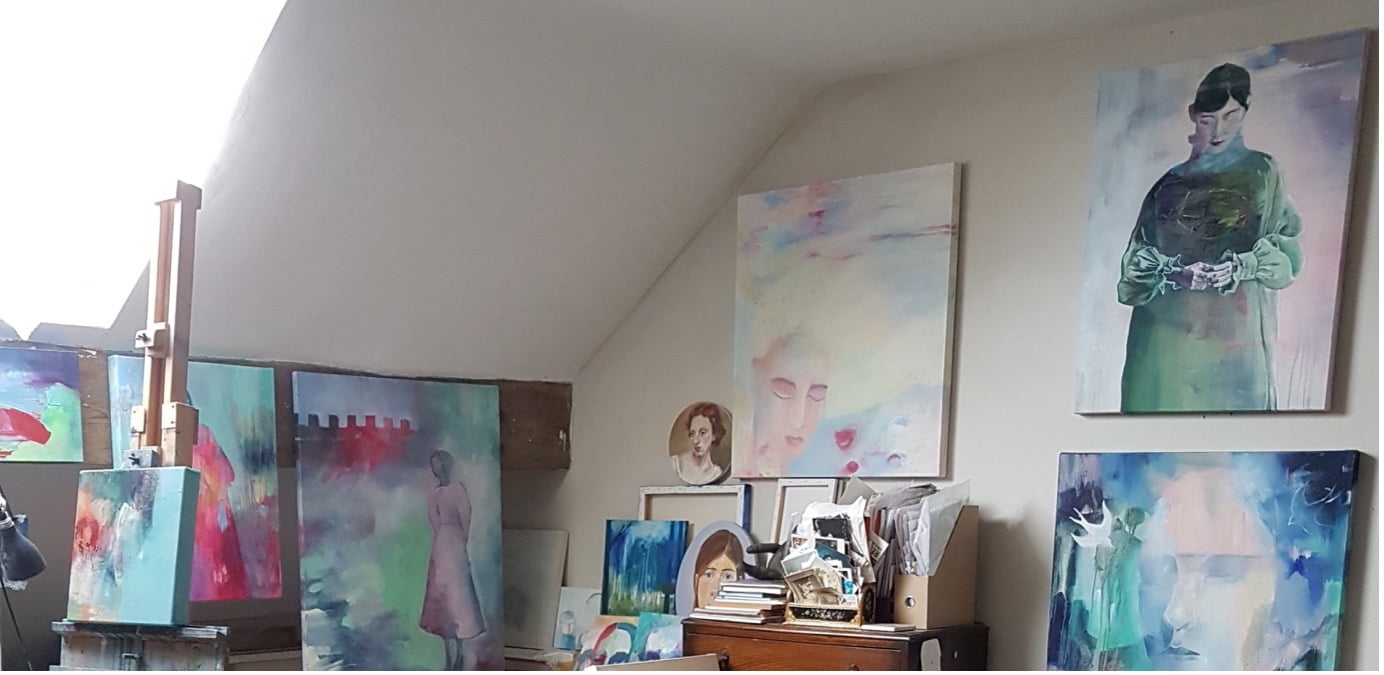
Top right: ‘The Quiet Within’ (2021), oil on canvas (60cm x 78cm). A piece that wasn’t working until turned upside down with a new approach.
Court: I suppose interior design included colour theory. You’ve got a great use of colour. Do you have a process or approach you take to painting? And what’s your starting point?
Caroline: My process seems to be ever evolving, it’s certainly no longer a direct route from A to B as it used to be (a pencil sketch, part from reference then developed imaginatively, finding the figure’s ‘daydream’, then sketch the drawing onto canvas and paint it). At the moment, the process is more intuitive and painterly, which excites me much more.
I start with colour and an element of chaos, covering the surface with spontaneous marks (sometimes in acrylics, sometimes in oil pastels and oil bars) and letting them mix wet into wet. Doing further layers, once the initial ones are dry and ‘encouraging’ the different layers of colours to have a conversation with each other. It’s where the colours can start to sing, so I always hope to keep a luminous quality. I really love any happy accidents from dribbles or the pigment granulating, or from scratching lines or rubbing away parts, and these are the kind of areas that suggest to me where the painting is going. Sometimes it takes weeks or months of the painting waiting around before I see a figure or idea emerging. I might even go back to an old sketchbook and it contains inspiration for just what the painting needs.
I do like to create a focal point by painting in the negative space, which makes the remaining visible early layers really glow. I also find that if I do start a painting with a more fixed idea, they often fail, and I end up turning the painting upside down and obliterating parts of it in frustration. These then become really exciting starting points for more spontaneous, emotive pieces of work. Several of my favourite paintings have risen from the ashes of disaster in this way. It’s quite a revelation.
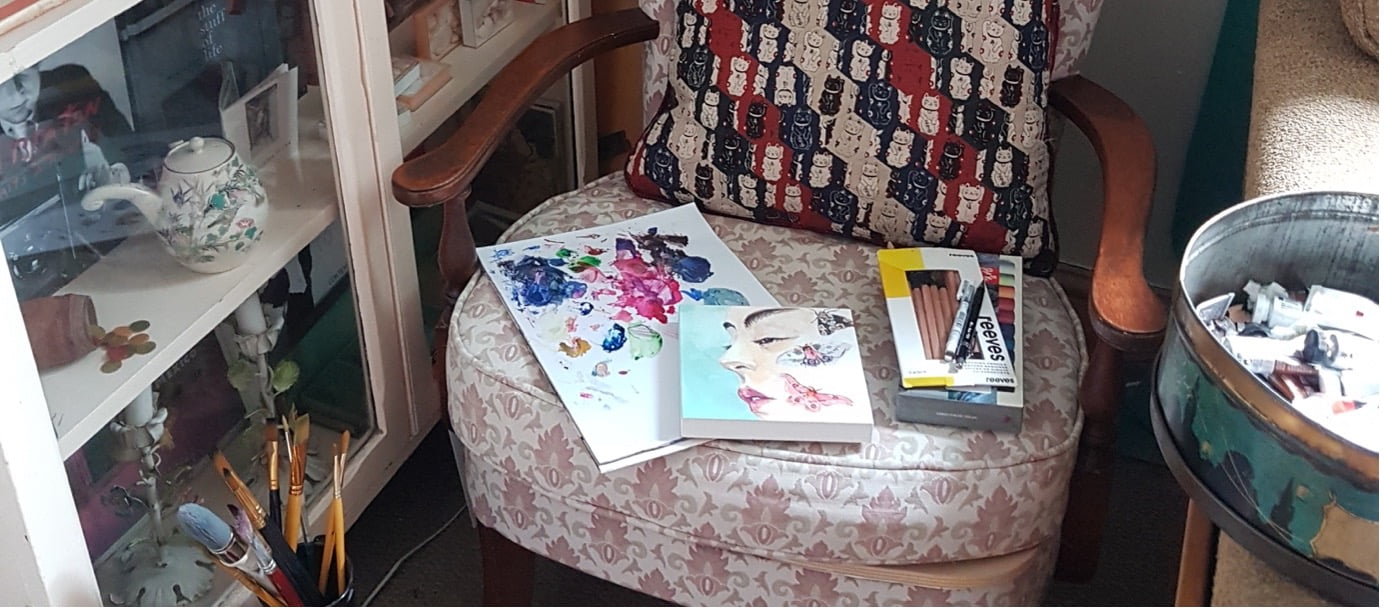
1950s chair that Caroline works from when making smaller scale works in the lounge.
Court: I love the idea that you can struggle with a painting, flip it upside down and begin to take a new approach and create some of your favourite pieces. So how long have you been in Bingley for? And was the attic space something that was always earmarked as studio space?
Caroline: We’ve been living in Bingley for 5 years, in a typical Victorian Yorkshire stone terrace. We lived in a bigger version of it for 11 years in Shipley, and in both houses the attics have been my studio, as well as housing everything for the vintage business. I definitely know how to make the best of the space – the beams are used for hanging wet paintings and our old Formica kitchen table is my painting table.
I do also have a very special 1950s upholstered armchair that we bought in Bingley about 15 years ago, and I sit in that downstairs when I’m sketching or working on my tiny gouache paintings. It means I can be more sociable with Julian if he’s downstairs reading, listening to CDs or watching TV. I find it a real treat when I have an afternoon to spare to lose myself in drawing or creating little gouache paintings. I’m a pretty messy oil painter, so it’s good to have an alternative place where I can be creative without needing a lot of space or a long stretch of time.
Court: How often do you get to the studio or to focus on your practice? And was that different during lockdown?
Caroline: At the moment, we are very busy running a vintage fair each month, and that is obviously our priority. So I’m lucky if I manage to spend one day a week being creative – either painting, drawing, researching or even applying for art opportunities.
I learnt during lockdown that when I focus on my painting, or on improving or experimenting, the benefits are evident. Because our vintage events business was so affected by the pandemic, I had the time and the impetus and even the necessity to devote myself to my art practice. The income from selling paintings, especially through the Artist Support Pledge, helped us to stay afloat for those 18 months where we couldn’t run vintage fairs. It would be so good to regain that momentum again. It’s a case of finding the balance with our vintage business.
Court: That’s fab that the Artist Support Pledge really worked well for you. Do you have a dream project that you would love to make happen?
Caroline: In the past I organised group exhibitions with graduate, emerging and established artists, and one day, I dream that I can do that again. The ultimate daydream is that it is a gallery space that brings together contemporary art with vintage furniture and homewares. They complement each other so well, and I love the dynamism and originality that both art and vintage bring to a space. I get a real buzz of energy from other artists’ work, so that would make me very happy!
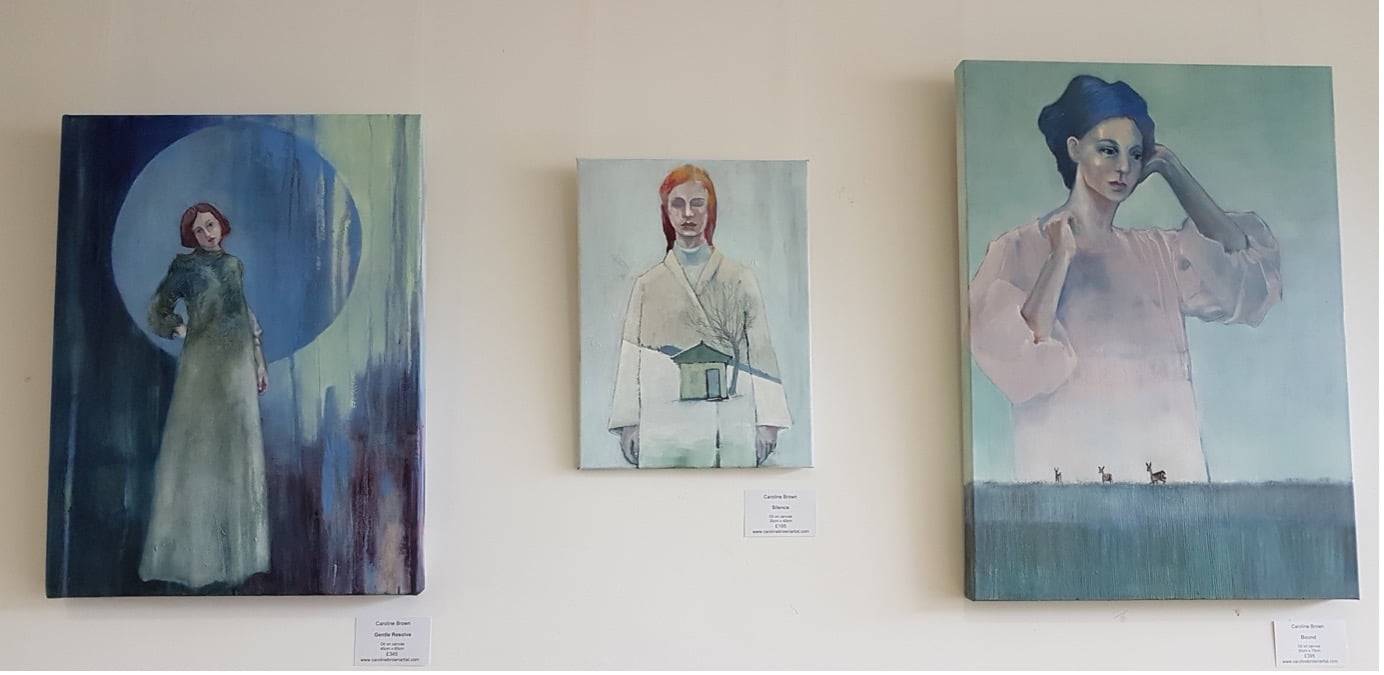
Current exhibition at The Craft House in Bingley, West Yorkshire
Court: That would be fantastic! What would you say is your career highlight to date?
Caroline: It’s definitely a highlight to be part of The Mercer Open, and I’m looking forward to seeing my painting amongst such fine company in such an inspiring space. Previous to that, a few months ago I entered an open at a beautiful little gallery in Cromford, Derbyshire called The Old Lock Up Gallery. One of my paintings won the ‘Curator’s Choice’ award, and part of the prize was that I’ll be a gallery artist at a special exhibition there in early 2023. That felt like an important step towards getting my work out into the wider world – to have an ongoing connection with an established gallery.
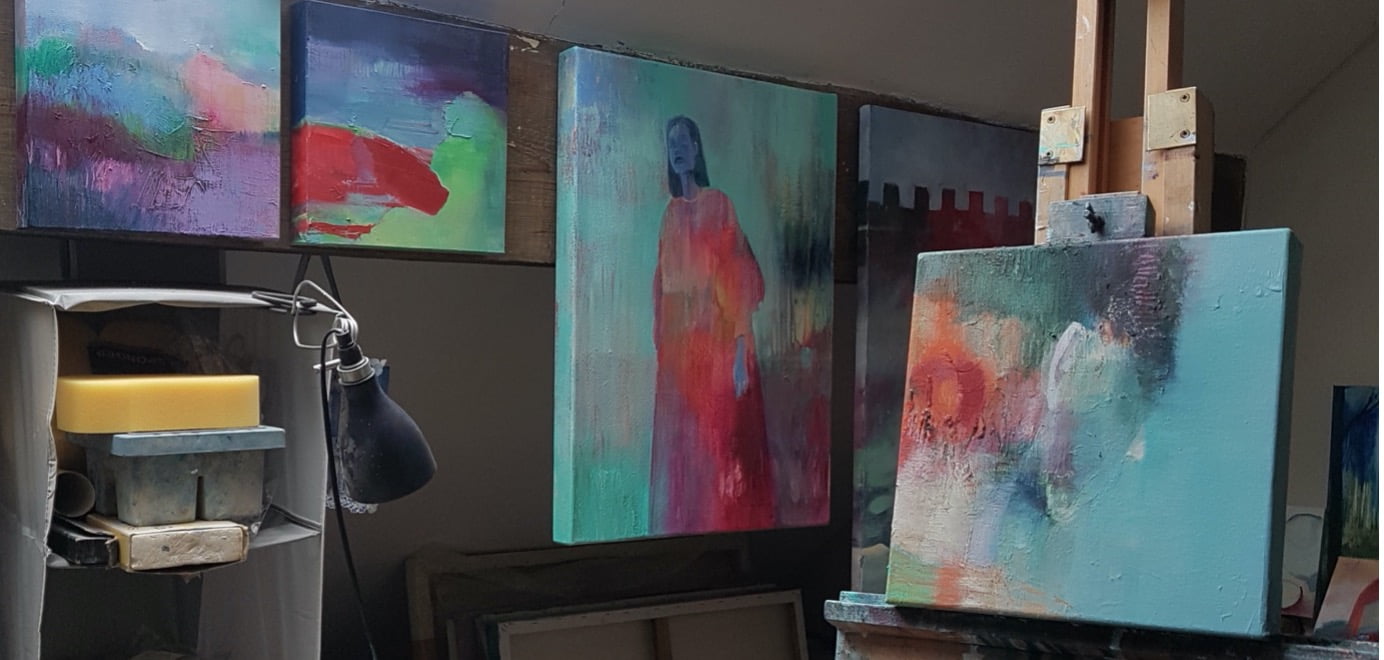
Middle painting: ‘The Lights of Dreams’ (2022) oil on canvas (45cm x 60cm) that will be show in The Mercer Open, Harrogate.
Court: So you’re showing in Derbyshire early in 2023 and you’re in The Mercer Open in Harrogate which opens 17th Sept. Have you got any other exhibitions coming up? And what’s the best way for people to follow your work?
Caroline: I have a solo exhibition at The Craft House in Bingley at the moment, it’s my third annual exhibition in their lovely, light-filled art cafe. The show finishes on 18th September and I hope to be back there next Summer. My only other confirmed exhibition is at The Old Lock Up Gallery in Cromford from 22nd January 2023 – 4th March 2023 in a show called ‘Selene’. I have a website www.carolinebrownartist.com and an Instagram account @carolinebrownartist if anyone would like to follow my work.
Court: That’s fabulous. I cannot wait to see some of those shows. Thank you so much for your time and I’m so looking forward to seeing more of your work.
Filed under: Art & Photography
Tagged with: art, column, court Spencer, fine art, interview, Leeds art, painting, Studio, studio visit



Comments